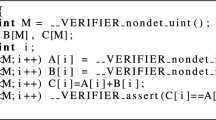Abstract
Automated test generation has received a lot of attention in recent decades, because it is one possible solution to the problems inherent to software testing: the need to write tests in the first place and providing test coverage for the human factor. De facto the most promising technique to automatically generate a test is dynamic symbolic execution assisted by an automated constraint solver, e.g., an SMT solver. This process is very similar to bounded model checking, which also deals with generating models from source code, asserting logic properties in it, and processing the returned model. This paper describes a prototype unit test generator for C based on a working bounded model checker called Borealis and shows that these two techniques are very similar and can be easily implemented using the same basic components. The prototype test generator has been evaluated on a number of examples and has shown good results in terms of test coverage and test excessiveness.
Similar content being viewed by others
References
Akhin, M., Belyaev, M., and Itsykson, V., Yet another defect detection: Combining bounded model checking and code contracts, PSSV'13, 2013, p. 1–11.
Armando, A., Mantovani, J., and Platania, L., Bounded model checking of software using SMT solvers instead of SAT solvers, Int. J. Software Tools Technol. Transf., 2009, no. 11(1), pp. 69–83.
Baudin, P., Filliatre, J.C., Hubert, T., Marche, C., Monate, B., Moy, Y., and Prevosto, V., ACSL: ANSI/ISO C Specification Language. Preliminary Design, version 1.4, 2008, preliminary edition, 2008.
Beck, K., Test-driven development: By example, Addison-Wesley Professional, 2003.
Beizer, B., Software testing techniques, Dreamtech Press, 2003.
Beyer, D., Competition on software verification, TACAS'12, 2012, p. 504–524.
Biere, A., Cimatti, A., Clarke, E.M., and Zhu, Yu., Symbolic model checking without BDDs, TACAS'9, 1999, p. 193–207.
Clarke, E., Kroening, D., and Lerda, F., A tool for checking ANSI-C programs, TACAS'04, 2004, p. 168–176.
Cohen, D.M., Dalal, S.R., Parelius, J., and Patton, G.C., The combinatorial design approach to automatic test generation, IEEE software, 1996, 13(5), pp. 83–88.
Cordeiro, L., Fischer, B., and Marques-Silva, J., SMT-based bounded model checking for embedded ANSI-C software, ASE'09, 2009, p. 137–148.
de Moura, L. and Bjrner, N., Z3: An Efficient SMT Solver, 2008, p. 337–340.
DeMilli, R.A. and Offutt, A.J., Constraint-based automatic test data generation, IEEE Trans. Software Eng., 1991, no. 17(9), pp. 900–910.
Godefroid, P., Klarlund, N., and Sen, K., DART: Directed automated random testing, ACM Sigplan Notices. ACM, 2005, vol. 40. pp. 213–223.
Hamlet, R., Random testing, Encyclopedia of Software Engineering, 1994.
Ivančicć, F. and Sankaranarayanan, S, NECLA Static Analysis Benchmarks.
Kumar, A. and Clair, J.St., CUnit. A unit testing framework for C. http://cunit.sourceforge.net/doc/index.html
Lattner, C., LLVM and Clang: Next generation compiler technology, The BSD Conference, 2008.
Lattner, C. and Adve, V., LLVM: A compilation framework for lifelong program analysis and transformation, CGO'04, 2004, p. 75–86.
Merz, F., Falke, S., and Sinz, C., LLBMC: Bounded model checking of C and C++ programs using a compiler IR, VSTTE'12, 2012, p. 146–161.
Bertrand, M., Applying ‘design by contract’, Computer, 1992, no. 25(10), pp. 40–51.
Myers, G.J., Sandler, C., and Badgett, T., The Art of Software Testing, John Wiley & Sons, 2011.
Nebut, C., Fleurey, F., le Traon, Y., and Jezequel, J.-M., Automatic test generation: A use case driven approach, IEEE Trans. Software Eng., 2006, no. 32(3), pp. 140–155.
Pacheco, C., Lahiri, Sh.K., Ernst, M.D., and Ball, Th., Feedback-directed random test generation, ICSE 2007, 2007, p. 75–84.
Sen, K., Marinov, D., and Agha, G., CUTE: A concolic unit testing engine for C, ACM, 2005, vol. 30.
Tillmann, N. and de Halleux, J., Pex-white box test generation for. Net, in Tests and Proofs, Springer, 2008, p. 134–153.
Xie, T., Tillmann, N., de Halleux, J., and Schulte, W., Fitness-guided path exploration in dynamic symbolic execution, IEEE, 2009, p. 359–368.
Author information
Authors and Affiliations
Corresponding author
Additional information
Original Russian Text © M. Petrov, K. Gagarski, M. Belyaev, V. Itsykson, 2014, published in Modelirovanie i Analiz Informatsionnykh Sistem, 2014, No. 6, pp. 83–93.
The article was translated by the authors.
About this article
Cite this article
Petrov, M., Gagarski, K., Belyaev, M. et al. Using a bounded model checker for test generation: How to kill two birds with one SMT solver. Aut. Control Comp. Sci. 49, 466–472 (2015). https://doi.org/10.3103/S0146411615070172
Received:
Published:
Issue Date:
DOI: https://doi.org/10.3103/S0146411615070172




